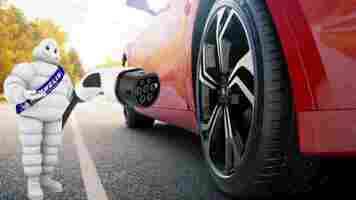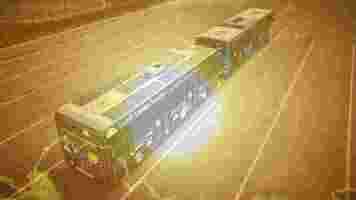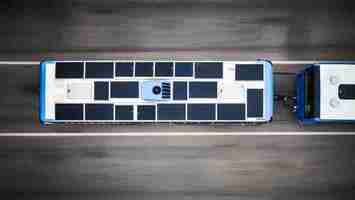Watch this Audi concept EV transform from grand tourer to roadster
Audi has unveiled its Skysphere concept car and, boy, if that’s the future of EVs, I’m sold.
The Skysphere is a rear-wheel-drive, two-door electric convertible that can transform from a luxurious grand tourer to a sporty roadster.
Yes, it transforms .


Thanks to its variable wheelbase, the concept car’s entire front end can extend or contract. Specifically, it can change from a long-wheelbase, stable grand tourer to a 9.8-inch-shorter (24.8cm) and 0.4-inch-lower (1cm) driver-centric roadster.

When you make the switch, the interior transforms as well.
During the grand tourer mode, the steering wheel and pedals move into an invisible area, expanding the passenger room, and the car goes into self-driving mode with Level 4 autonomy.
In the roadster mode, t he steering wheel and pedals come of the bulkhead, as the passenger seat moves rearward and the driver’s portion of the dash comes forward to serve as a control panel.
The Skyshpere has been inspired by the 1931 Horch 853 , but unlike the classic, it has a 465kWh battery pack and can go from 0 to 62mph in just four seconds.
Interestingly, it’s the first in a series of Audi concept cars that will follow, the Grandsphere and the Urbansphere — which we can expect to have similar or even more advanced features.
The Skypshere will make its public debut on its home turf in California, in August 13, 2021. It’s not certain if it will ever reach production, but a man can hope.
Watch the video above, to check out how the concept car was created.
Do EVs excite your electrons? Do ebikes get your wheels spinning? Do self-driving cars get you all charged up?
Why on earth is Michelin launching special ‘EV tires’?
Michelin recently launched two types of tires in China, specifically made for electric vehicles.

The new tires are meant to show Michelin’s “concern for Chinese consumers and the company’s development strategy,” Shanghai Daily reports.
But… why would EVs need special tires to begin with?
Well, it all boils down to weight. EVs generally weigh more than gasguzzlers, which means they wear tires down much faster. Also, worn tires will reduce the cars’ range, so there’s a lot to win by preventing that from happening.
Michelin aims to tackle these exact issues with the e.PRIMACY and the Pilot Sport EV tires, designed for high-performance and sports electric cars.
The e.PRIMACY is made for both fuel-powered and battery-powered vehicles, and thanks to its low rolling resistance it can increase an EV’s range by approximately 7% (30 km for a vehicle range of 400 km).
The real game-changer though is the Pilot Sport EV tire, specifically addressing the needs of electric sports cars.
According to Michelin, it features optimal grip on dry and wet roads, taking into account the higher weight and weight-distribution characteristics associated with EV sports cars.
What’s more, it’s claimed to be wear-resistant in response to the high torque and acceleration forces, while it offers very low rolling resistance, increasing the range by up to 60 km.
The Pilot Sport EV tires are also designed to have 20% less road noise, thanks to a custom-developed polyurethane foam that muffles sounds. That’s an important attribute given that the tires are the loudest part of electric vehicles which are otherwise doing a great job at reducing noise pollution.
While the e.PRIMACy tires are focusing more on the European market, the Pilot Sport EV alternative will be available in both Europe and North America by the end of 2021.
Do EVs excite your electrons? Do ebikes get your wheels spinning? Do self-driving cars get you all charged up?
Then you need the weekly SHIFT newsletter in your life. Click here to sign up .
Munich just got its first solar-powered bus — why arent all buses solar?
The question I am always asked when I mention anything related to solar energy is this: why isn’t the technology as ubiquitous as the sun?

So today I am excited to share the news that solar-power transport company Sono Motors is deploying its tech on a bus for the first time — in partnership with the Münchner Verkehrsgesellschaft (Munich Transport Company, MVG).
You probably know Sono Motors from its work building Sion, the solar electric car . The Sono solar technology replaces traditional paint with proprietary integrated solar panels that can form for various applications. Unlike vehicles with rooftop solar panels alone, it comes with 456 solar half-cells on the hood, fenders, sides, roof, and rear.
I sat down with Laurin Hahn, co-founder, and CEO, to ask about the shortage of solar deployment up until now, and find out about the company’s latest partnership.
He explained that the reasons for solar’s slow start have been cost and inefficiency:
Buses get the solar treatment
Today the company is deploying its solar technology as a diesel bus retrofit solution. As Hahn notes, “There are thousands of buses in existence. And they will not be put away tomorrow.” So, the first step is to reduce the diesel consumption of existing bus fleets.
Sono Motors’ solar bus trailer will soon hit the roads in the Munich metropolitan area, offering savings of up to 2,500 liters of diesel per year for a medium-sized fleet of 300 buses. This could lead to an annual local CO2 saving potential of more than 6.5 metric tonnes per bus.
Each trailer comes with 20 semi-flexible special photovoltaic (PV) modules, providing over 2,000 watts of energy to power the vehicles’ battery and electrical loads, such as heating, ventilation, air conditioning, and the trailer’s steering system.
Besides saving diesel, the additional electricity stabilizes the battery’s energy supply. This extends its service life and reduces maintenance costs. The energy generated is monitored online using integrated software.


Sono Motors has already signed more than ten letters of intent and contracts with companies such as MAN, easymile, and ARI Motors since the beginning of 2021.
The Sono solar technology is suitable for integration into existing vehicles and during the production phase of manufacturing.
When e-buses are factory-equipped with Sono’s solar technology, the additional range can be generated immediately through solar energyon the roof and sides.
Hahn explained that this reduces the standstill times for charging processes and protects the battery through a constant charging process. “As a result, the e-bus can operate longer.”
The Sion solarEV is still on track
The company still plans to roll out the solarEV, publishing news of their development progress on their website each fortnight.
Hahn shared, “We’ve been very transparent about our car development, including what’s going well and what’s going not so well.” The company is so far unaffected by the industry’s supply chain woes, but is monitoring the situation closely.
The Sion costs a mere €28,500 ($31,600). The company expects to start production in the first half of 2023. There are over 15,000 reservations valued at $385 million.
It’s a great day for solar tech, and it’s a great day for the environment.